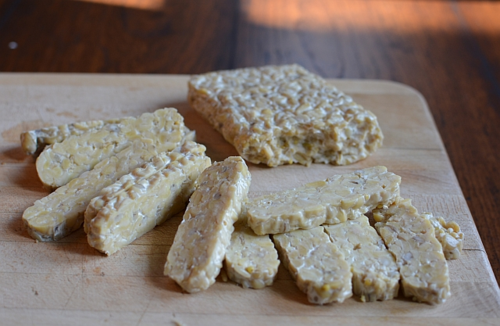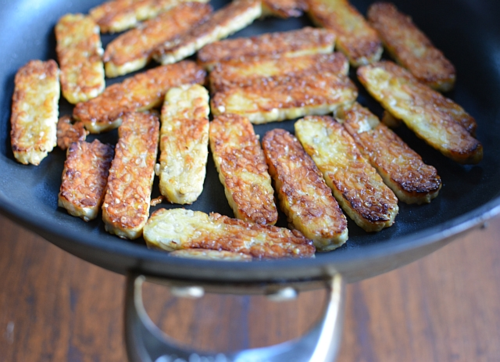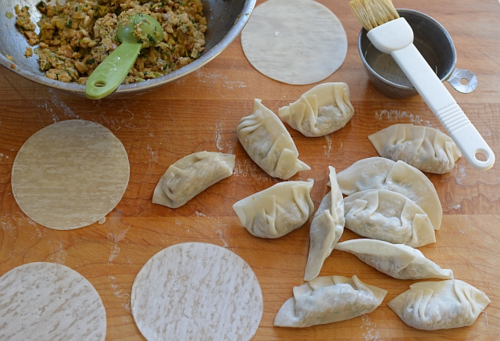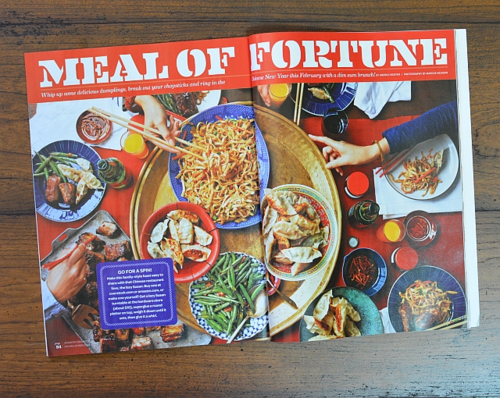I love tofu but have not been able to wrap my head around tempeh. I’ve tried various recipes over the years and things just never tasted great. Last year in Singapore, my friend Christopher Tan took us to an Indonesian restaurant and the fried tempeh was amazing, nutty and multidimensional. I sensed that the process for culturing and fermenting the soybeans in Asia yields a superior product. Plus, many cooks there are comfortable with using tempeh. I began to warm up to tempeh.
A couple of vegetarian and vegan friends in the States have urged me to tackle it. Case in point: Randy Clemens contributed a sriracha tempeh recipe for the banh mi book. I was skeptical at first but it turned out to be a knockout. The tempeh was marinated, baked, then lightly seared. The result was big flavor in a vegan package. Randy wrote a great blog post about his lemongrass and sriracha tempeh banh mi.
While I was doing banh mi book events in Seattle in September, Michael Natkin mentioned a tempeh pot sticker in his book, Herbivoracious. It’s really easy and delicious, he said. I put it on my to-try list and gave it a whirl this weekend. I couldn’t agree with him more.
Tempeh has a flavor that has to be tempered and tamed. One way to deal with that is to cut it up into slabs and fry it with oil. Browning tempeh, whether it’s by searing, pan-frying, shallow-frying or deep-frying, transforms the firm pieces into nutty goodness.
After browning, Michael crumbles up the tempeh. Its appearance and texture also get transformed. The idea is to make the tempeh small enough to function well in a pot sticker filling. Slabs and large chunks do not play well with dumpling wrappers. But aside from functionality, for an omnivore like me, crumbled tempeh kind of resembles meat.
There’s napa cabbage and lots of scallion (green onion) in Michael’s filling too. I opted to use sesame oil for earthy flavor and extra richness. Additionally, I tried a gluten-free soy sauce to see what would happen. It’s a tad tart and light so sugar and spice (fennel) got added to the filling. The result tasted nice. The good thing with vegetarian fillings is that you can taste and tweak it as you go. Keep that in your back pocket.
Per Michael’s recipe, I used purchased pot sticker skins. I think the filling would be excellent in DIY dumpling wrappers too.
I panfried a small batch for us to snack on. My husband surprisingly really liked the tempeh pot stickers. He deemed them as good as any other filling I’ve made. “I’d eat that regularly,” he said.
Try this out if you’re looking to tackle tempeh or just want to add a vegan dumpling to your repertory. Thanks, Michael, for the tempeh nudge.
And, if you have tempeh insights to share, I’m all ears and mouth!
Recipe
Tempeh and Scallion Pot Sticker
Yield: 32 to 48 pot stickers
Ingredients:
- 8 ounces (240 g) tempeh, such as Trader Joe’s brand
- 3 tablespoons canola oil, plus more as needed
- 6 to 7 ounces (180 to 210 g) finely chopped napa cabbage (use whole leaves)
- ⅔ to ¾ cup (150 to 180 ml) minced scallions (use white and green parts)
- ½ teaspoon sugar
- ¼ teaspoon ground fennel or ⅛ teaspoon white pepper
- 2 teaspoons sesame oil
- 1 tablespoon plus 1 teaspoon Shaoxing rice wine or dry sherry
- 2 tablespoons plus ¼ cup regular or gluten-free soy sauce
- Salt
- 1 tablespoon cornstarch
- 2 to 3 tablespoon unseasoned rice vinegar
- 1 to 2 teaspoons homemade chile oil or purchased chile oil
- 1 generous teaspoon minced or grated fresh ginger
- 48 purchased pot sticker/gyoza skins or 1 batch basic dumpling dough (see Asian Dumplings, page 22)
Instructions
- Cut the tempeh into slabs, each as thick as a smart phone such as the iPhone 4 or 5. Heat a nonstick skillet over medium-high heat and add about 1 ½ tablespoons of oil. Gently fry the tempeh for 3 to 5 minutes, flipping midway, until golden on both sides. Add oil as needed to moisten and facilitate browning. Transfer to plate or bowl. Set aside until cool enough to handle.
- Lower the heat slightly, add a splash of oil, if needed, then the napa cabbage. Cook, stirring for about 3 minutes, until soft and starting to brown. When done, it will be roughly a third of the original volume after most of liquid has rendered and evaporated. Remove from the heat.
- Use your fingers to crumble the cooled tempeh into very small pieces. Add the cabbage, scallion, sugar, fennel (or white pepper), sesame oil, rice wine (or sherry), and 2 tablespoons soy sauce. Stir to combine well. Taste and add salt, if needed. Mix in the cornstarch well to bind well. Set aside for 15 to 30 minutes to meld flavors. Makes about 2 cups.
- Meanwhile, mix up the sauce by combining: ¼ cup of soy sauce with the vinegar, chile oil, and ginger. Set aside.
- Use the filling to make dumplings. Use about 2 teaspoons for purchased wrappers, wetting the rim with water before closing. Use about 1 tablespoon for homemade wrappers; no water is needed for sealing.
- Pan-fry the dumplings in a skillet with oil and water. (See this recipe for guidance. You don’ t have to make a slurry for a crisp skirt, unless you want to. Just use water.) Eat with the sauce.
P.S. If you are a Rachel Ray magazine reader, there’s a dumpling and dim sum feature in the January/February 2015 issue. I wrote it and the recipes are delicious and fun.
And, places like Amazon and Barnes and Nobles are temporarily out of The Banh Mi Handbook. The third and fourth printing are on their way, due to land in early February, which means the book will be restocked by late February. This is a drag but orders will be filled as soon as possible. So let’s make dumplings!!!
More dumpling and dim sum recipes at VWK: (also check Asian Dumplings)





















